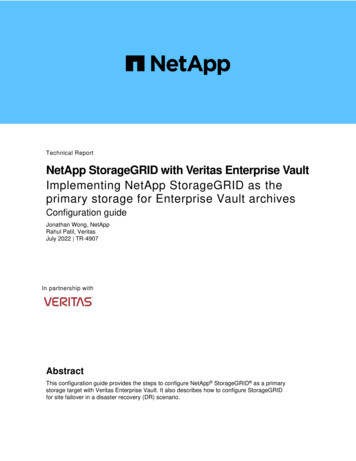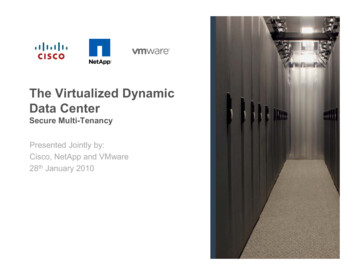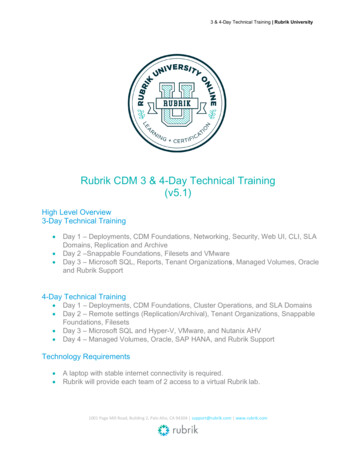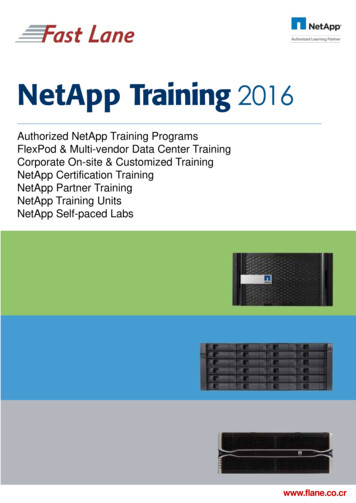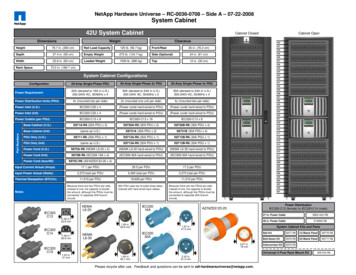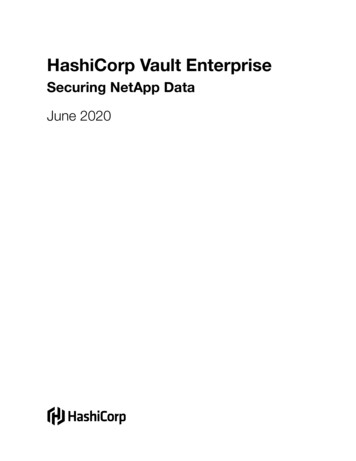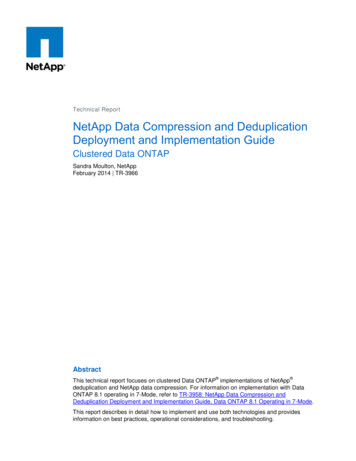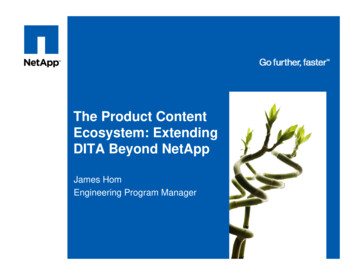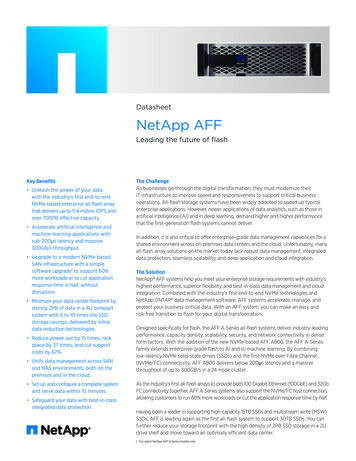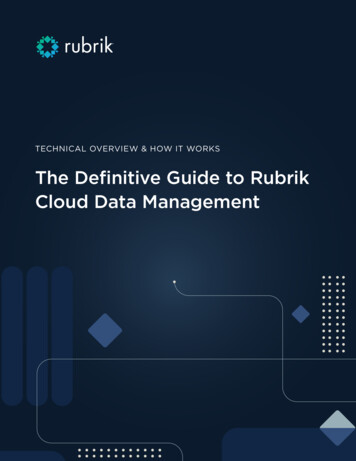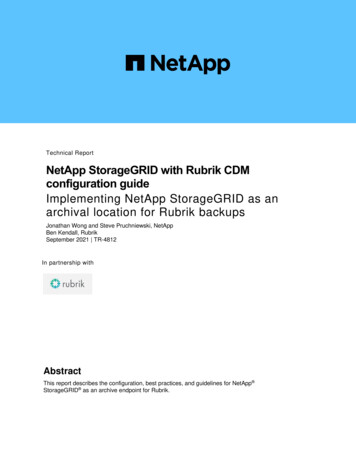
Transcription
Technical ReportNetApp StorageGRID with Rubrik CDMconfiguration guideImplementing NetApp StorageGRID as anarchival location for Rubrik backupsJonathan Wong and Steve Pruchniewski, NetAppBen Kendall, RubrikSeptember 2021 TR-4812In partnership withLogoAbstractThis report describes the configuration, best practices, and guidelines for NetApp StorageGRID as an archive endpoint for Rubrik.
TABLE OF CONTENTSIntroduction . 3Scope .3Rubrik Cloud Data Management .3NetApp StorageGRID .3Reasons to choose StorageGRID .3Requirements . 4Rubrik .5StorageGRID .5Configuring StorageGRID with Rubrik . 5Configuring an S3 tenant on StorageGRID .5Configuring StorageGRID as an archival location .7Configuring VM backup and restore .9Creating an SLA .9Selecting a VM to archive to StorageGRID .12Creating an ILM rule to protect the Rubrik archive data .13Multisite configuration (optional) .16Configuration recommendations . 18Where to find additional information . 19Version history . 19LIST OF FIGURESFigure 1) NetApp StorageGRID with Rubrik as archival location. .42NetApp StorageGRID with Rubrik CDMconfiguration guide 2021 NetApp, Inc. All rights reserved. For Internal Use Only
IntroductionScopeRubrik Cloud Data Management (CDM) is a backup and recovery solution for enterprise workloads. Ascustomers set out to modernize their data management and data protection practices, Rubrik’s CDMplatform is an increasingly attractive solution. For longer-term backup retention, data can be archivedfrom Rubrik to the public cloud or to object-based storage such as NetApp StorageGRID .This document is a reference for configuring NetApp StorageGRID as an archival target. It also coversconfiguring a backup policy in Rubrik, configuring a S3 tenant in StorageGRID, and an informationlifecycle management (ILM) policy in StorageGRID, as well as sizing and performance guidelines forStorageGRID with Rubrik.The recommendations in this document are suggested guidelines. When designing a solution, it isimportant to consider as many aspects of the backup environment as possible.This document is intended for NetApp employees and partners who are familiar with StorageGRIDconcepts and terminology, and who also have technical familiarity with backup solutions.Rubrik Cloud Data ManagementRubrik’s CDM platform organizes and protects data on the premises, at the edge, and in the cloud. Userscan easily automate backup jobs by configuring SLAs and archiving data to public or private clouds,including NetApp StorageGRID object-based storage.Rubrik scales linearly, so customers are not hampered by forklift upgrades. Deduplication, compression,and other data services scale in line with the cluster to maximize efficiency and savings. Furthermore,Rubrik simplifies data recovery by allowing “Google-like” search functionality to recover only thedatabase, applications, or files needed.In addition, Rubrik is built on an API-first architecture that is fully featured and easy to learn, allowingcustomers to automate their data workflows.NetApp StorageGRIDNetApp StorageGRID is a software-defined object storage solution that supports industry-standard objectAPIs such as Amazon S3 API and OpenStack Swift API. StorageGRID uses intelligent, policy-driven datamanagement to store, protect, and preserve data, enabling you to create metadata-driven object lifecyclepolicies to optimize durability, performance, cost, and location across multiple geographies.In addition, NetApp StorageGRID is built as a scale-out, node-based architecture that gives you the agilityto increase capacity and performance on demand across your sites. Scaling is asymmetrical and assimple as adding more storage nodes, which are available as an appliance, software only/bare metal, orvirtual machine.Reasons to choose StorageGRIDBy reducing complexity and providing flexible, policy-driven data management, Rubrik delivers simplicityand efficiency. At the same time, given the popularity and ever-expanding use case for object storage,customers are choosing NetApp StorageGRID for similar reasons: policy-driven data management,simplicity, and flexibility.NetApp and Rubrik are delivering newly integrated solutions that offer policy-based simplicity, costeffective scale, and cloud mobility.StorageGRID makes a superior archive endpoint in the following scenarios:3NetApp StorageGRID with Rubrik CDMconfiguration guide 2021 NetApp, Inc. All rights reserved. For Internal Use Only
You operate in a hybrid cloud model to optimize costs and avoid vendor lock-in. You can deploylocally or globally with no proprietary hardware lock in. You want a system that can grow organically. Refresh, expand, and migrate non-disruptively withoutthe dependencies that other systems have. You require granular data protection to comply with data sovereignty and other regulatory compliancerequirements. Dynamically balance data durability, performance, cost, and location with the industry’sleading lifecycle policy engine. You want to archive data and leverage object storage for other use cases. Easily stand up otherworkflows with our multi-tenant capabilities and hybrid cloud capabilities.Figure 1) NetApp StorageGRID with Rubrik as archival location.RequirementsAlthough StorageGRID and Rubrik have been implemented in the field as far back as StorageGRID 10.4and Rubrik 2.3, this document validates the current General Availability (GA) versions: StorageGRID 11.5.0 Rubrik CDM 6.0.0-p1-12566As prerequisites, the following must be configured on StorageGRID: FQDN for S3 endpoint; for example, s3.company.com API service endpoint server certificates Commercial trusted SSL is preferred Self-signed is acceptable but requires Rubrik Support to enable S3 tenant created with S3 keys (Swift API is not supported for this solution.) Load balancer endpoint Disable grid encryption and compression (default setting). Rubrik already sends data encrypted andcompressed.4NetApp StorageGRID with Rubrik CDMconfiguration guide 2021 NetApp, Inc. All rights reserved. For Internal Use Only
RubrikRubrik can be deployed on a hardware appliance, software at the edge, software in the cloud, and onthird-party industry platforms.For this guide, a minimum configuration was deployed on VMware: One Rubrik EdgeStorageGRIDStorageGRID can be deployed on a hardware appliance, software only/bare-metal servers, or ahypervisor. For this test, a minimum configuration was deployed on a VMware hypervisor: One admin node Three storage nodesHTTP and HTTPS supportStorageGRID supports both HTTP and HTTPS. HTTPS is enabled by default. HTTP is recommendedonly for lab environments and is disabled by default.Customers can choose to use standard ports with a third-party load balancer or create a load-balancerendpoint (11.3 and later). For details, see Configuring Load Balancer Endpoints in the StorageGRID 11.5Documentation Center.Configuring StorageGRID with RubrikConfiguring an S3 tenant on StorageGRID1. Log in to the StorageGRID Grid Manager Interface.2. Click Tenants on the top menu bar and select Create.3. Create a tenant account:5NetApp StorageGRID with Rubrik CDMconfiguration guide 2021 NetApp, Inc. All rights reserved. For Internal Use Only
a. Enter a display name.b. Select S3 as the protocol.c.Enter a password for the tenant’s local root user.4. After the tenant account is created, select Sign In next to the tenant to access the Tenant ManagerInterface (TMI) and log in.6NetApp StorageGRID with Rubrik CDMconfiguration guide 2021 NetApp, Inc. All rights reserved. For Internal Use Only
5. In the TMI, go to S3 My Access Keys, and click Create Key.6. Step through the process and be sure to download your Access Key and Secret Access Key.The StorageGRID S3 Access and Secret Access Keys are now ready to be used with Rubrik.Configuring StorageGRID as an archival location1. Log in to the Rubrik Cluster using an account with Admin permission.2. Click the cog symbol at the top right in the Rubrik GUI. Under System Configuration, select ArchivalLocations.3. Click the to create a new archival location and then follow these configuration steps:a. Set Archival Type as Object Store and set Object Store Vendor as S3 Compatible(StorageGRID).7NetApp StorageGRID with Rubrik CDMconfiguration guide 2021 NetApp, Inc. All rights reserved. For Internal Use Only
b. Enter an S3 Access Key and Secret Access Key.c.Set Host Name to the FQDN of the S3 endpoint. If not using standard HTTPS port 443, enter theport of the load balancer endpoint:d. Enter a bucket prefix, for example, sg.e. Rubrik creates multiple buckets named prefix-rubrik-x.f.Select the number of buckets to be used.g. Rubrik stores all data for a source (VM, database, etc.) in a single bucket along with the metadatathat allows Rubrik to validate and perform recovery. NetApp recommends creating no more thanone bucket per Rubrik Archive.h. Generate an RSA key for encryption. Run the following command on a secure computer that has the OpenSSL toolkit:openssl genrsa -out rubrik encryption key.pem 2048 Paste the RSA key into the window.Rubrik uses this key to encrypt the archival data.i.Click Add.4. The StorageGRID S3 object store is added to the Rubrik Cluster as an archival location and isavailable to be used by Rubrik SLAs.8NetApp StorageGRID with Rubrik CDMconfiguration guide 2021 NetApp, Inc. All rights reserved. For Internal Use Only
Configuring VM backup and restoreRubrik supports backup for different enterprise workloads such as databases and virtual machines.Rubrik also supports different hypervisors – VMware vSphere (ESXi), Microsoft Hyper-V, and NutanixAHV. For this test, we connected Rubrik to a vCenter Server for VM backup.1. Click the cog symbol at the top right in the Rubrik GUI to add the vCenter Servers.2. In the Rubrik GUI click, the to add vCenter and then follow these configuration steps:a. Enter a vCenter IP or FQDN.b. Enter a vCenter username and password.3. When the vCenter has been added, Rubrik makes an inventory of VMs, hosts, and folders.Creating an SLARubrik SLAs define protection levels for workloads composed of snapshot protection and retention,replication, and archiving. For this test, we configured an SLA targeted at archiving to StorageGRID.1. From the left-side menu, select SLA Domains Local Domains.2. In the Rubrik GUI, click the to create a new SLA domain and then follow these configuration steps:9NetApp StorageGRID with Rubrik CDMconfiguration guide 2021 NetApp, Inc. All rights reserved. For Internal Use Only
a. Enter an SLA domain name.b. Specify snapshot protection and retention.3. Click Next.4. Enable Archiving and select the configured StorageGRID archival target.10NetApp StorageGRID with Rubrik CDMconfiguration guide 2021 NetApp, Inc. All rights reserved. For Internal Use Only
5. Verify the settings for SLA frequency, retention, and archiving.11NetApp StorageGRID with Rubrik CDMconfiguration guide 2021 NetApp, Inc. All rights reserved. For Internal Use Only
Selecting a VM to archive to StorageGRID1. From the left-side menu, select Virtual Machines vSphere VMs.2. In the Rubrik UI, select a VM and click Manage Protection.3. Select an SLA domain and click Next.12NetApp StorageGRID with Rubrik CDMconfiguration guide 2021 NetApp, Inc. All rights reserved. For Internal Use Only
4. Review the protection settings and click SubmitCreating an ILM rule to protect the Rubrik archive dataIn StorageGRID, an ILM rule contains the instructions for placing objects in the system over time. Rulesperform actions based on matching criteria such as bucket name or user-specified metadata fields.In this test, we replicated our archival data to three sites and retained the replications for a year beforetransitioning to erasure coding.1. Log in to the StorageGRID Grid Management Interface (GMI).2. When StorageGRID is configured as a Rubrik archival location, buckets are automatically createdbased on the Rubrik configurations set in section 3.2. To see the buckets, follow these steps.a. In the StorageGRID GMI, go to Tenants Sign In (next to the Rubrik Tenant) to access theTenant Manager.b. Enter the Rubrik tenant root account and password.c.13Go to S3 Buckets.NetApp StorageGRID with Rubrik CDMconfiguration guide 2021 NetApp, Inc. All rights reserved. For Internal Use Only
3. Create an ILM rule to manage the data. In the StorageGRID GMI, go to ILM ILM Rules Create.a. Enter a name.b. Enter a description.c.Specify criteria that the Tenant Account must be the configured Rubrik tenant.d. Specify criteria that the Bucket Name must start with prefix-rubrik. (Prefix configured insection 3.2.)e. Click Next.4. Example configuration of an ILM placement rule:a. Replicate three copies across three data centers for geo distribution.b. Transition to erasure coding after a year to reduce storage space.c.Verify that the retention diagram is correct.d. Click Save.14NetApp StorageGRID with Rubrik CDMconfiguration guide 2021 NetApp, Inc. All rights reserved. For Internal Use Only
5. Go to ILM Policies Create Proposed Policy:a. Enter a name.b. Enter a reason for the change.c.Select the rules to apply.d. Click Apply.e. Select a default rule.f.15Click Save.NetApp StorageGRID with Rubrik CDMconfiguration guide 2021 NetApp, Inc. All rights reserved. For Internal Use Only
6. Activate the policy.Multisite configuration (optional)It is a common deployment architecture to have a primary data center and a secondary data center bothdeploying Rubrik and StorageGRID. The secondary data center ensures backups can still be archivedand restored during a full primary data center failover. To create a basic configuration for a two-sitedeployment, follow these steps:1. Deploy a two-site StorageGRID grid with a primary Admin Node in the primary data center and a nonprimary Admin Node in the secondary data center.16NetApp StorageGRID with Rubrik CDMconfiguration guide 2021 NetApp, Inc. All rights reserved. For Internal Use Only
The Admin Nodes act as the S3 endpoint to provide load balancing to the Storage Nodes. S3endpoints can also be provided by dedicated Gateway Nodes.2. To enable connectivity to StorageGRID during data center failures, configure a high availability group.This ties the two S3 endpoints into an active-backup group with a virtual IP (VIP).3. The VIP is the IP address that Rubrik connects to when configuring the archival location. During aprimary data center loss, the VIP reroutes to the S3 endpoint in the secondary data centertransparently.4. Make sure that the backups archived to StorageGRID are replicated into both primary and secondarydata centers. That way, during a data center failure, the object data is still available.5. Create two storage pools; one for the primary data center and another for the secondary. Storagepools are logical groupings of nodes used to define object placement.a. Go to ILM Storage Pools Createb. Follow the steps and create a storage pool for each data center.17NetApp StorageGRID with Rubrik CDMconfiguration guide 2021 NetApp, Inc. All rights reserved. For Internal Use Only
6. Create an ILM rule specifying object data to be stored in both sides. In this example, a one copy ineach site rule was created.a. Set Ingest Behavior to Balanced (default). This makes sure that when a site is lost, object datacan still be written to StorageGRID.7. The above configuration example results in the following:a. A virtual S3 endpoint IP that during primary data center loss reroutes traffic to the secondary datacenter automatically.b. When backups are archived to StorageGRID, one copy is made per data center. If the primarydata center fails, a replicated copy still exists in the secondary data center ready for retrieval.c.Both are transparent to Rubrik. The archival location continues to use the same IP and bucketname.Configuration recommendationsRubrik already encrypts and compresses its data. Therefore, NetApp recommends disabling encryptionand compression on StorageGRID.Rubrik is not versioning aware, so versioning on StorageGRID buckets should be disabled.Rubrik has not been validated with Cloud Storage Pools. If customers want to use capacity from thepublic cloud, you can configure Rubrik to support additional cloud storage targets.StorageGRID performs better with larger objects, and you can increase part size to 128MB or more toincrease throughput.Rubrik, as of the current release tested in this document, performs nonexistent HEADs as part of theconnectivity check. NetApp recommends changing the bucket consistency of the StorageGRID buckets to18NetApp StorageGRID with Rubrik CDMconfiguration guide 2021 NetApp, Inc. All rights reserved. For Internal Use Only
available to enable greater availability during node or site loss. For more information, read about theStorageGRID consistency controls. For information about how to change the consistency level, see theinstructions in the StorageGRID documentation center.Where to find additional informationTo learn more about the information that is described in this document, review the following documentsand/or websites: NetApp StorageGRID .jsphttps://www.netapp.com/us/media/ds-3613.pdf TR-6773 StorageGRID Performance 11.5https://fieldportal.netapp.com/content/205463 StorageGRID Solution 648 Rubrik resourceshttps://www.rubrik.com/resources/ Rubrik support articles (requires tps://support.rubrik.com/s/article/000002692 Rubrik rikincVersion historyVersionDateDocument version historyVersion 1.0December 2019Initial release.Version 1.1May 2020Updated sizing and performance sectionVersion 1.2September 2021 19NetApp StorageGRID with Rubrik CDMconfiguration guideUpdated to the latest template.Updated screenshots to latest Rubrik and StorageGRIDversionIncluded information on multisite deploymentsUpdated “Configuration recommendations” section 2021 NetApp, Inc. All rights reserved. For Internal Use Only
Refer to the Interoperability Matrix Tool (IMT) on the NetApp Support site to validate that the exactproduct and feature versions described in this document are supported for your specific environment. TheNetApp IMT defines the product components and versions that can be used to construct configurationsthat are supported by NetApp. Specific results depend on each customer’s installation in accordance withpublished specifications.Copyright InformationCopyright 2019–2021 NetApp, Inc. All Rights Reserved. Printed in the U.S. No part of this documentcovered by copyright may be reproduced in any form or by any means—graphic, electronic, ormechanical, including photocopying, recording, taping, or storage in an electronic retrieval system—without prior written permission of the copyright owner.Software derived from copyrighted NetApp material is subject to the following license and disclaimer:THIS SOFTWARE IS PROVIDED BY NETAPP “AS IS” AND WITHOUT ANY EXPRESS OR IMPLIEDWARRANTIES, INCLUDING, BUT NOT LIMITED TO, THE IMPLIED WARRANTIES OFMERCHANTABILITY AND FITNESS FOR A PARTICULAR PURPOSE, WHICH ARE HEREBYDISCLAIMED. IN NO EVENT SHALL NETAPP BE LIABLE FOR ANY DIRECT, INDIRECT,INCIDENTAL, SPECIAL, EXEMPLARY, OR CONSEQUENTIAL DAMAGES (INCLUDING, BUT NOTLIMITED TO, PROCUREMENT OF SUBSTITUTE GOODS OR SERVICES; LOSS OF USE, DATA, ORPROFITS; OR BUSINESS INTERRUPTION) HOWEVER CAUSED AND ON ANY THEORY OFLIABILITY, WHETHER IN CONTRACT, STRICT LIABILITY, OR TORT (INCLUDING NEGLIGENCE OROTHERWISE) ARISING IN ANY WAY OUT OF THE USE OF THIS SOFTWARE, EVEN IF ADVISED OFTHE POSSIBILITY OF SUCH DAMAGE.NetApp reserves the right to change any products described herein at any time, and without notice.NetApp assumes no responsibility or liability arising from the use of products described herein, except asexpressly agreed to in writing by NetApp. The use or purchase of this product does not convey a licenseunder any patent rights, trademark rights, or any other intellectual property rights of NetApp.The product described in this manual may be protected by one or more U.S. patents, foreign patents, orpending applications.Data contained herein pertains to a commercial item (as defined in FAR 2.101) and is proprietary toNetApp, Inc. The U.S. Government has a non-exclusive, non-transferrable, non-sublicensable, worldwide,limited irrevocable license to use the Data only in connection with and in support of the U.S. Governmentcontract under which the Data was delivered. Except as provided herein, the Data may not be used,disclosed, reproduced, modified, performed, or displayed without the prior written approval of NetApp,Inc. United States Government license rights for the Department of Defense are limited to those rightsidentified in DFARS clause 252.227-7015(b).Trademark InformationNETAPP, the NETAPP logo, and the marks listed at http://www.netapp.com/TM are trademarks ofNetApp, Inc. Other company and product names may be trademarks of their respective owners.Rubrik, the Rubrik graphic, Rubrik Polaris, Polaris GPS, Polaris Radar, Rubrik Envision, Rubrik Edge,Rubrik Mosaic, and Datos IO are trademarks or registered trademarks of Rubrik, Inc. in the U.S. and/orother countries. All other trademarks are the property of their respective owners.TR-4812-092120NetApp StorageGRID with Rubrik CDMconfiguration guide 2021 NetApp, Inc. All rights reserved. For Internal Use Only
Rubrik Cloud Data Management Rubrik's CDM platform organizes and protects data on the premises, at the edge, and in the cloud. Users can easily automate backup jobs by configuring SLAs and archiving data to public or private clouds, including NetApp StorageGRID object-based storage.
